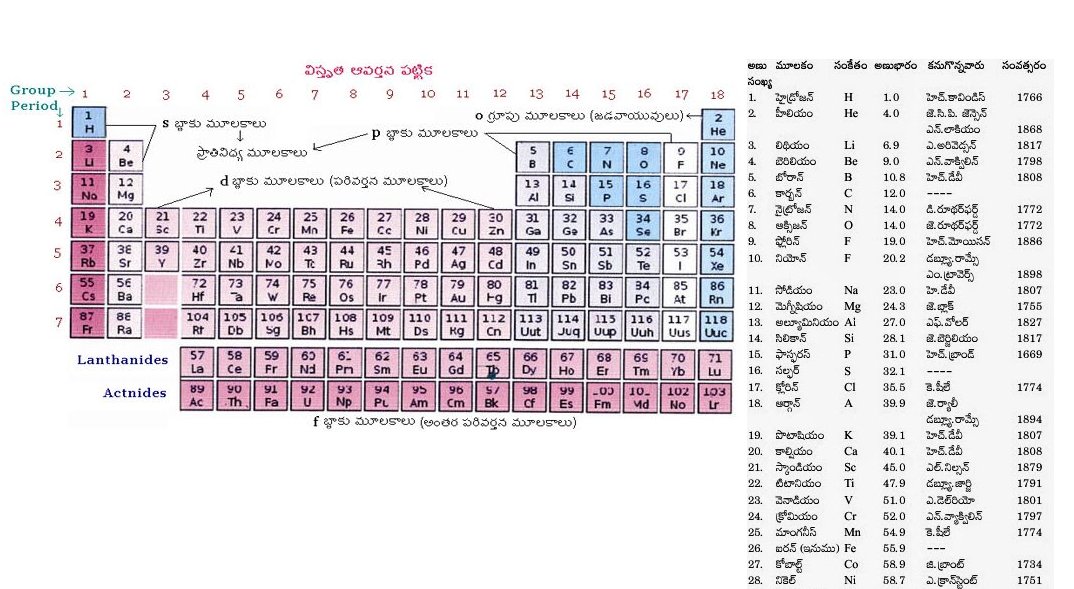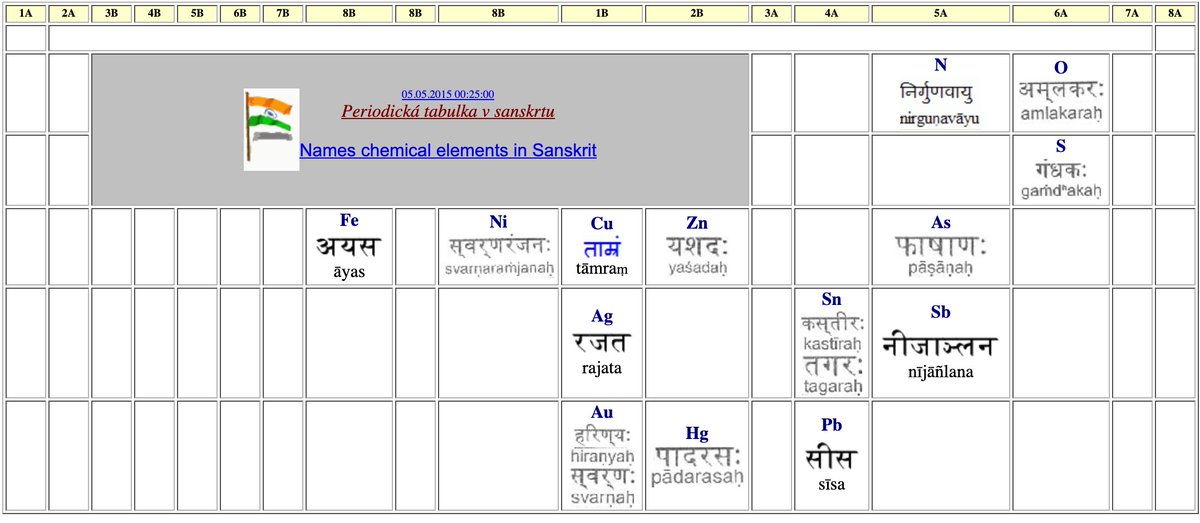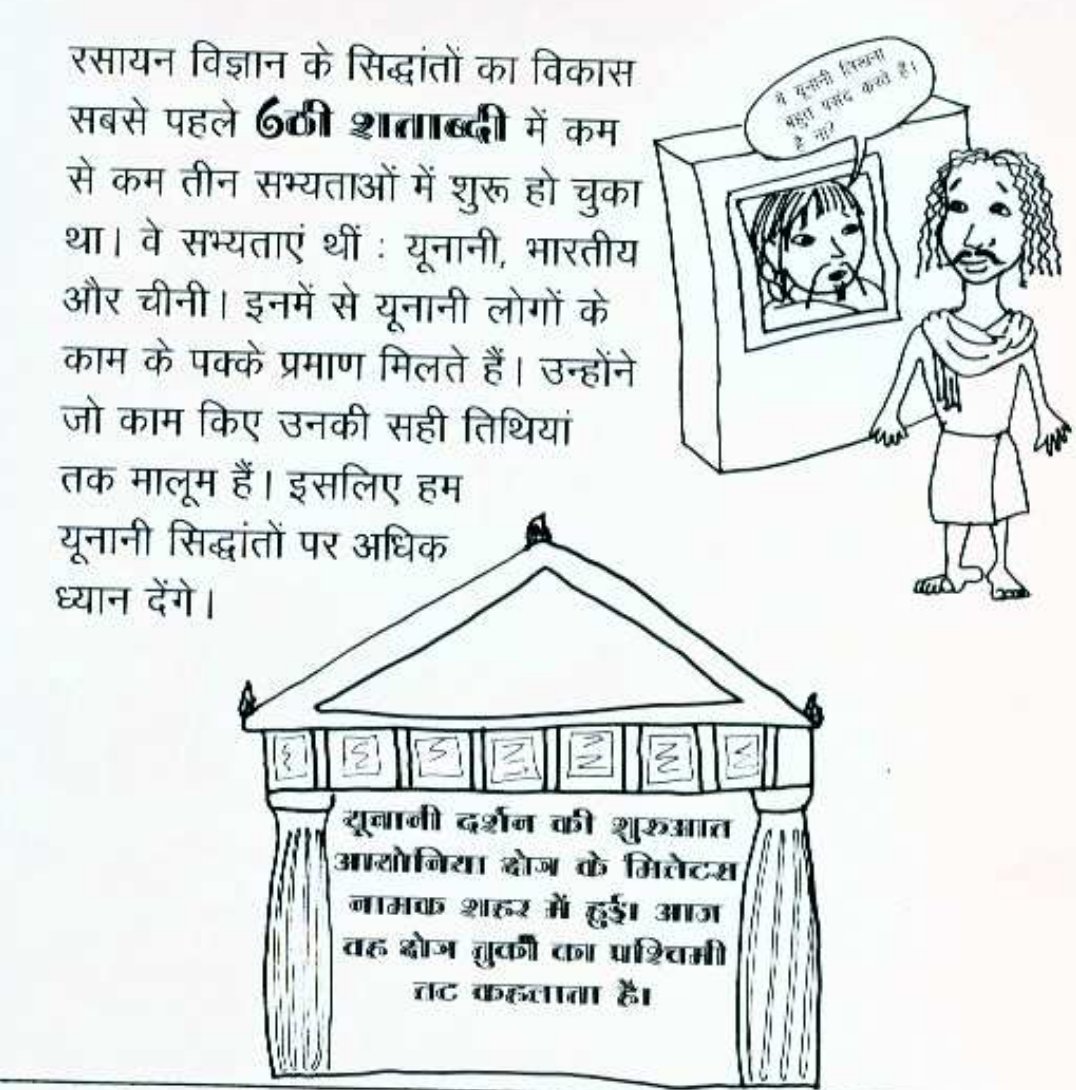Why does it matter to have chemical names in Indian languages? The name of a compound often reveals the chemical structure, and that prompts creative thinking. Indian language students are fundamentally disadvantaged here and are forced to switch to English for any serious work.
Let's consider a simple example: CO2 or "carbon dioxide". How do you say that in Telugu? "kārban ḍayāksaiḍ" కార్బన్ డయాక్సైడ్.
How do you say that in German? Kohlendioxid.
(Kohl: coal)
(Kohlenstoff: coal-material i.e, Carbon)
How do you say that in French? Dioxyde de Carbone.
How do you say that in German? Kohlendioxid.
(Kohl: coal)
(Kohlenstoff: coal-material i.e, Carbon)
How do you say that in French? Dioxyde de Carbone.
Let's consider another simple example: H20 or "hydrogen dioxide", that is water. How do you say that in Telugu? "haiḍrōjan ḍayāksaiḍ" హైడ్రోజన్ డయాక్సైడ్
How do you say that in German? Wasserstoffdioxid
(Wasser: water)
(Wasserstoff: water-material, i.e, Hydrogen)
How do you say that in German? Wasserstoffdioxid
(Wasser: water)
(Wasserstoff: water-material, i.e, Hydrogen)
Some of the elements in the periodic table are given original native names in Indian languages. For example, Hydrogen is known as "udajani" ఉదజని उदजनि in Telugu. But it is not used regularly. The names of the compounds are Hydrogen are copied entirely from English.
Here is the periodic table of elements in Telugu. Telugu readers would see that most are copied from English, including even Hydrogen.
Many Indians don't know that other European languages actually don't use English names, but have their own standardized naming conventions.
Many Indians don't know that other European languages actually don't use English names, but have their own standardized naming conventions.
Setting up a standardized naming convention for chemical compounds in Sanskrit is not a very hard task. I wonder why Sanskrit scholars have not looked at this problem with the diligence that it deserves. Other Indian languages can then use the Sanskrit names or develop their own.
Apparently, the Russian chemist Mendeleev, who invented the Periodic Table for organizing the chemical elements, was inspired by the Pāṇinian grammar of Sanskrit. He even used Sanskrit prefixes "ēka, dva" etc. in his version of naming some elements. https://swarajyamag.com/books/sanskrit-and-mendeleevs-periodic-table-of-elements
Indian scientific tradition also made some fundamental discoveries in chemistry. Many chemical elements and compounds were first discovered in India. The Indian heritage in metallurgy was actually a source of great wealth. You can read more here:
https://www.tf.uni-kiel.de/matwis/amat/def_en/articles/metallurg_heritage_india/metallurgical_heritage_india.html
https://www.tf.uni-kiel.de/matwis/amat/def_en/articles/metallurg_heritage_india/metallurgical_heritage_india.html
So why is it that Indian languages have not come up with an indigenous naming convention for chemical elements? This completely beats me. 
Here is the list of the chemical elements in the periodic table which have a Sanskrit name. See all the gaps !
http://canov.jergym.cz/vyhledav/variant9/sanskrt/sanskrit.html

Here is the list of the chemical elements in the periodic table which have a Sanskrit name. See all the gaps !
http://canov.jergym.cz/vyhledav/variant9/sanskrt/sanskrit.html
The cute periodic table in Hindi at the start of this thread is from this book.
http://www.arvindguptatoys.com/arvindgupta/story-chemistry-hindi.pdf
At the very outset, the book claims that the Greek methodology in chemistry is superior to the Indian or Chinese. This is how science is being taught since the colonial era.
http://www.arvindguptatoys.com/arvindgupta/story-chemistry-hindi.pdf
At the very outset, the book claims that the Greek methodology in chemistry is superior to the Indian or Chinese. This is how science is being taught since the colonial era.
I found the names of a few chemicals on the Hindi wikipedia, which were reconstructed from Hindi.
Nitrous Oxide (N20: laughing gas) is द्विभूयाति जारेय in Hindi.
Equivalent German name: Distickstoffmonoxid
Hindi name is good, but not as exact as German.
https://hi.wikipedia.org/wiki/%E0%A4%A6%E0%A5%8D%E0%A4%B5%E0%A4%BF%E0%A4%AD%E0%A5%82%E0%A4%AF%E0%A4%BE%E0%A4%A4%E0%A4%BF_%E0%A4%9C%E0%A4%BE%E0%A4%B0%E0%A5%87%E0%A4%AF
Nitrous Oxide (N20: laughing gas) is द्विभूयाति जारेय in Hindi.
Equivalent German name: Distickstoffmonoxid
Hindi name is good, but not as exact as German.
https://hi.wikipedia.org/wiki/%E0%A4%A6%E0%A5%8D%E0%A4%B5%E0%A4%BF%E0%A4%AD%E0%A5%82%E0%A4%AF%E0%A4%BE%E0%A4%A4%E0%A4%BF_%E0%A4%9C%E0%A4%BE%E0%A4%B0%E0%A5%87%E0%A4%AF
If any Indian chemists / Sanskrit scholars are interested in this problem, please refer to this page which lists the names of all the elements in English, their etymology and origin.
We don't need to translate all names, but the most reactive chemicals.
https://en.wikipedia.org/wiki/List_of_chemical_elements
We don't need to translate all names, but the most reactive chemicals.
https://en.wikipedia.org/wiki/List_of_chemical_elements
I also want to draw the attention of the interested scholars to the pioneering work of James Ballantyne towards developing a Sanskrit nomenclature for Chemistry (and in other sciences). It is an interesting work, although biased with some ulterior motives. https://twitter.com/vakibs/status/1265962075509133314?s=20
In fact, it's possible to apply the extraordinary power of the Sanskrit language and grammar to derive ultra concise and precise names. We can think of it in multiple stages. At the first stages, we need to build an expressiveness equivalent to English. https://twitter.com/vakibs/status/1265967760766631936?s=20
Anyway, let’s list the positives from the English nomenclature of the elements. We can try to keep these positives in our translation.
1) The suffixes -gen for the reactive gases, from Latin (to generate). Since Sanskrit is closely related, it can be replaced with -jani జని जनि
1) The suffixes -gen for the reactive gases, from Latin (to generate). Since Sanskrit is closely related, it can be replaced with -jani జని जनि
Examples:
Hydrogen: water-generator: udajani ఉదజని उदजनि
Oxygen: acid-generator: āmlajani ఆమ్లజని आम्लजनि
2) When these elements create compounds, they get the -ide suffix. It can be replaced with -ēya एय ఏయము
Hydride: udēya उदेय ఉదేయము
Oxide: āmlēya आम्लेय ఆమ్లేయము
Hydrogen: water-generator: udajani ఉదజని उदजनि
Oxygen: acid-generator: āmlajani ఆమ్లజని आम्लजनि
2) When these elements create compounds, they get the -ide suffix. It can be replaced with -ēya एय ఏయము
Hydride: udēya उदेय ఉదేయము
Oxide: āmlēya आम्लेय ఆమ్లేయము
I am not that picky on the exact names for the elements. But there has to be an equivalent logic for naming the compounds, with a replacement of suffixes. There are places where this is not being followed, e.g, jārēya जारेय for -oxide, perhaps from Sanskrit “jara” जर (aged).
Such names can be given additionally. But the technical names must follow a simple logic, that can be checked by students or practitioners. Then the names of the chemical compounds etc. can be effectively standardized. This is a must for industrial use, where precision is needed.
3) The number is reflected in a prefix: mono-1, di-2, tri-3.. The Sanskrit equivalents: ēka एक ఏక-1, dvi द्वि ద్వి-2, tri त्रि త్రి-3..
Examples:
Dihydrogen Oxide H20: dvyudāmlēya द्व्युदाम्लेय ద్వ్యుదామ్లేయం
H2O2: dvyudadvyāmlēya द्व्यदद्व्याम्लेय ద్వ్యుదద్వ్యామ్లేయం
Examples:
Dihydrogen Oxide H20: dvyudāmlēya द्व्युदाम्लेय ద్వ్యుదామ్లేయం
H2O2: dvyudadvyāmlēya द्व्यदद्व्याम्लेय ద్వ్యుదద్వ్యామ్లేయం
Now the names of the elements at the top of the periodic table must be translated, especially those elements which appear commonly on earth and form a wide range of compounds: carbon, nitrogen, fluorine, chlorine etc. Their compounds must be given the corresponding suffixes.
I will give a few suggestions to the names of these elements, with the idea of arriving at short but meaningful names, preferably rooted in the history of usage of the elements in India. If you have alternate suggestions, please do also think of the same criteria.
The word “carbon” is related to “charred, burnt, coal etc”. I like the name “Kshāma” क्षाम క్షామము, which means scorched/burnt in Sanskrit.
- Carbide: Kshāmēya क्षामेय క్షామేయము
An example for a compound: Carbon dioxide CO2: Kshāmadvyāmlēya क्षामद्व्याम्लेय క్షామద్వ్యామ్లేయము.
- Carbide: Kshāmēya क्षामेय క్షామేయము
An example for a compound: Carbon dioxide CO2: Kshāmadvyāmlēya क्षामद्व्याम्लेय క్షామద్వ్యామ్లేయము.
The word “Nitrogen” is related to its presence in “Niter” or “salt petre” which is used historically for fire works. In fact, the very first literary mention of Nitrate is in India, in Chānakya’s Arthaśāstra, where he called it “Agnichūrna” (fire mixture), a weapon of war.
I find it fitting to name “Nitrogen” on this basis of Indian heritage in chemistry. For a long time, India produced the best nitrate in the world.
The Sanskrit suffix -ka (maker) can be used to coin “Agnika” अग्निक అగ్నికము for Nitrogen.
-Nitride: Agnikēya अग्निकेय అగ్నికేయము
The Sanskrit suffix -ka (maker) can be used to coin “Agnika” अग्निक అగ్నికము for Nitrogen.
-Nitride: Agnikēya अग्निकेय అగ్నికేయము
Example compounds of Nitrogen:
N2O: Dvyagnikaikāmlēya द्व्यग्निकैकाम्लेय ద్వ్యగ్నికైకామ్లేయము
NO2: Agnikadvyāmlēya अग्निकद्व्याम्लेय అగ్నికద్వ్యామ్లేయము
NH3: Agnikatryudēya अग्निकत्र्युदेय అగ్నికత్ర్యుదేయము
Please note that these are technical names, not common names.
N2O: Dvyagnikaikāmlēya द्व्यग्निकैकाम्लेय ద్వ్యగ్నికైకామ్లేయము
NO2: Agnikadvyāmlēya अग्निकद्व्याम्लेय అగ్నికద్వ్యామ్లేయము
NH3: Agnikatryudēya अग्निकत्र्युदेय అగ్నికత్ర్యుదేయము
Please note that these are technical names, not common names.

For Chlorine, I like its connection to the bile (gastric acid), which is greatly studied in Āyurvēda, and known as “pitta” पित्त. Hydrochloric acid forms a significant part of this. I want to name Chlorine as “Pittaka” पित्तक పిత్తకము.
-Chloride: Pittakēya पित्तकेय పిత్తకేయము
-Chloride: Pittakēya पित्तकेय పిత్తకేయము
Sulphur is already widely known as “Gandhaka” गन्धक గంధకము, as it was isolated and used since ancient times in India.
-Sulphide: Gandhakēya गन्धकेय గంధకేయము
-Sulphate (-SO4): Gandhakāmlita गन्धकाम्लित గంధకామ్లితము
I used the suffix “-ita” (made of) for the -ate.
-Sulphide: Gandhakēya गन्धकेय గంధకేయము
-Sulphate (-SO4): Gandhakāmlita गन्धकाम्लित గంధకామ్లితము
I used the suffix “-ita” (made of) for the -ate.
Similarly, the Carbonate radical (-CO3) can be translated as “Kshāmāmlita” क्षामाम्लित క్షామామ్లితము.
The Bicarbonate radical (-HCO3) can be translated as “Udakshāmāmlita” उदक्षामाम्लित ఉదక్షామామ్లితము.
If you have alternative names, please think of the related words as well.
The Bicarbonate radical (-HCO3) can be translated as “Udakshāmāmlita” उदक्षामाम्लित ఉదక్షామామ్లితము.
If you have alternative names, please think of the related words as well.

 Read on Twitter
Read on Twitter




